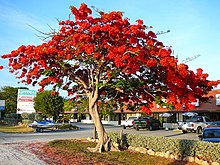Delonix regia
| Delonix regia | |
|---|---|
 |
|
| Tree in full bloom in the Florida Keys | |
| Scientific classification | |
| Kingdom: | Plantae |
| (unranked): | Angiosperms |
| (unranked): | Eudicots |
| (unranked): | Rosids |
| Order: | Fabales |
| Family: | Fabaceae |
| Subfamily: | Caesalpinioideae |
| Genus: | Delonix |
| Species: | D. regia |
| Binomial name | |
|
Delonix regia (Boj. ex Hook.) Raf. |
|
| Synonyms | |
|
|
Delonix regia is a species of flowering plant in the bean family Fabaceae, subfamily Caesalpinioideae. It is noted for its fern-like leaves and flamboyant display of flowers. In many tropical parts of the world it is grown as an ornamental tree and in English it is given the name royal poinciana or flamboyant. It is also one of several trees known as "flame tree".
This species was previously placed in the genus Poinciana, named for Phillippe de Longvilliers de Poincy, the 17th century governor of Saint Christophe (Saint Kitts). It is a non nodulating legume.
The flowers of Delonix regia are large, with four spreading scarlet or orange-red petals up to 8 cm long, and a fifth upright petal called the standard, which is slightly larger and spotted with yellow and white. They appear in corymbs along and at the ends of branches. The naturally occurring variety flavida (Bengali: Radhachura) has yellow flowers. The pods are green and flaccid when young and turn dark-brown and woody. They can be up to 60 cm long and 5 cm wide. The seeds are small, weighing around 0.4 g on average. The compound leaves have a feathery appearance and are a characteristic light, bright green and are doubly pinnate. Each leaf is 30–50 cm long with 20 to 40 pairs of primary leaflets or pinnae, each divided into 10–20 pairs of secondary leaflets or pinnules.
Delonix regia is endemic to the Madagascar's dry deciduous forests but has been introduced into tropical and sub-tropical regions worldwide. In the wild it is endangered, but it is widely cultivated elsewhere.
The royal poinciana requires a tropical or near-tropical climate, but can tolerate drought and salty conditions. It prefers an open, free-draining sandy or loamy soil enriched with organic matter. The tree does not like heavy or clay soils and flowers more profusely when kept slightly dry.
In addition to its ornamental value, it is also a useful shade tree in tropical conditions, because it usually grows to a modest height (mostly 5 meters, but it can reach an maximum height of 12 meters) but spreads widely, and its dense foliage provides full shade. In areas with a marked dry season, it sheds its leaves during the drought, but in other areas it is virtually evergreen.
...
Wikipedia

